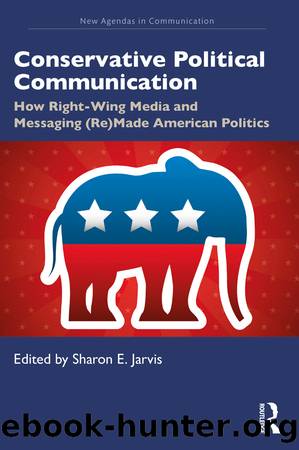Conservative Political Communication: How Right-Wing Media and Messaging (Re)Made American Politics by Sharon E Jarvis

Author:Sharon E Jarvis [Jarvis, Sharon E]
Language: eng
Format: epub
ISBN: 9781351187220
Goodreads: 55783967
Publisher: Routledge
Published: 2021-04-15T00:00:00+00:00
Priming Partisan and Gender Identities
In Americaâs predominantly two-party system, women voters are also partisan voters and must grapple with their gender and partisan identities when voting. In turn, candidates need to tap into these identities in their appeals to Republican women. Candidates can do so by emphasizing a âshared characteristicâ between themselves and Republican women voters and that âshould help the group become a frame of reference for membersâ political attitudes and behaviorsâ (Paolino, 1995, p. 297). Republican men can prompt a party connection, whereas Republican women can create a dual connection because they share gender and party affiliation with Republican women voters. Candidates can create these connections via agenda setting and priming. Candidates can focus on certain topics that are more important to Republican women and thus set their agendas. Once the agenda is set, these topics can become primed in womenâs minds, and women will âgive those issues more weight when making their vote decisionsâ (Schaffner, 2005, p. 805). This chapter explores how Republican men and women tried to prime these shared characteristics and influence womenâs vote formation processes.
Partisan identity is a strong predictor of vote choice. In recent midterm and presidential election years, for example, over 90% of partisans voted for their respective party in House races (âExit polls,â 2014, 2016). One key way Republican candidates can prime their shared partisanship with Republican voters is by discussing certain political issues. Political issue ownership suggests that the public perceives partisans to be more capable in handling certain issues, and thus these issues have become deeply associated with what it means to identify as and run as a Republican or Democrat (Petrocik, 1996). This ownership has intensified over time because âissues increasingly get defined along a left-right ideological continuum because parties are becoming increasingly structured that wayâ (Jochim & Jones, 2013, p. 361). Surveys show that the public perceives Republicans as owning issues such as the economy, immigration, national security, international affairs, and crime/law and order, whereas Democrats are perceived as owning education, healthcare, the environment, reproductive rights, and social welfare (Petrocik, 1996; Pew, 2014). Candidates reinforce votersâ perceptions and emphasize party-owned issues in their communication (Benoit & Hansen, 2002, 2004; Meeks, 2016; Petrocik, 1996; Petrocik, Benoit, & Hansen, 2003). This emphasis can be electorally beneficial. Benoit (2007) analyzed presidential TV spots from 1952 to 2004 and found that Democratic and Republican winners stressed party-owned issues more than Democratic and Republican losers. Therefore, if Republican men and women candidates are trying to (1) prime womenâs partisan identities and (2) tap into the positive association between Republicans and owned issues, they should discuss their partyâs owned issues. In turn, I predict candidates will discuss Republican-owned issues more than Democrat-owned issues (H1).
Alternately, candidates can prime Republican womenâs gender identity via identity politics. Put simply, identity politics asserts that political allegiances can be formed based on some demographic similarity (e.g., gender, race, ethnicity, or religion; see Plutzer & Zipp, 1996). Identity politics is similar to Pomperâs (1975) âdependent voter,â who casts their vote based on demographic identification with a candidate.
Download
This site does not store any files on its server. We only index and link to content provided by other sites. Please contact the content providers to delete copyright contents if any and email us, we'll remove relevant links or contents immediately.
Asking the Right Questions: A Guide to Critical Thinking by M. Neil Browne & Stuart M. Keeley(5577)
Autoboyography by Christina Lauren(5155)
Eat That Frog! by Brian Tracy(4381)
Dialogue by Robert McKee(4272)
Sticky Fingers by Joe Hagan(4060)
Journeys Out of the Body by Robert Monroe(3539)
Annapurna by Maurice Herzog(3398)
Full Circle by Michael Palin(3350)
Schaum's Quick Guide to Writing Great Short Stories by Margaret Lucke(3280)
Elements of Style 2017 by Richard De A'Morelli(3280)
The Art of Dramatic Writing: Its Basis in the Creative Interpretation of Human Motives by Egri Lajos(2945)
Why I Write by George Orwell(2851)
The Diviners by Libba Bray(2841)
In Patagonia by Bruce Chatwin(2830)
The Mental Game of Writing: How to Overcome Obstacles, Stay Creative and Productive, and Free Your Mind for Success by James Scott Bell(2819)
The Fight by Norman Mailer(2801)
Atlas Obscura by Joshua Foer(2759)
Venice by Jan Morris(2496)
The Elements of Style by William Strunk and E. B. White(2416)
